Agricultural Sciences
Vol.4 No.7A(2013), Article ID:34805,5 pages DOI:10.4236/as.2013.47A002
Growth and yield responses of broccoli cultivars to different rates of nitrogen in western Chitwan, Nepal
![]()
1Institute of Agriculture and Animal Science, Tribhuvan University, Kathmandu, Nepal
2Department of Agroecology, Aarhus University, Research Centre Foulum, Tjele, Denmark;
*Corresponding Author: Tanka.Kandel@agrsci.dk
Copyright © 2013 Raj Kumar Giri et al. This is an open access article distributed under the Creative Commons Attribution License, which permits unrestricted use, distribution, and reproduction in any medium, provided the original work is properly cited.
Received 26 April 2013; revised 31 May 2013; accepted 15 June 2013
Keywords: Brassica oleracea L. italica; Curd Yield; Growth; Varieties
ABSTRACT
A field experiment was conducted with the objective to determine the optimum rate of nitrogen (N) fertilizer for effective growth and yield of two varieties of broccoli in southern plain of Nepal. The experiment was laid out with two-factorial completely random block design (RCBD) comprising two varieties of broccoli (Calabrese and Green Sprouting) and five N rates (0, 50, 100, 150 and 200 kg ha−1) with three replication in each treatment combinations. The effects of variety and N rate on total curd yield were significant but the interaction effect was non-significant. Green Sprouting produced 11% higher total curd than Calabrese. Similarly, curd production increased N rate up to 200 kg ha−1 reaching a maximum of 14.47 t ha−1. This indicated that optimum level of N could be beyond the rates tested in this study, which needs further experimentation.
1. INTRODUCTION
Broccoli (Brassica oleracea L. italica) is a comparatively newer winter vegetable crop in Nepal [1]. Although broccoli stands in the 17th position in terms area of cultivation covering 141 hectares with 9 t/ha productivity in Chitwan district its production is mostly limited to kitchen garden level [2]. However, commercial cultivation of broccoli has started in recent years in southern plain including Chitwan district with limited governmental support.
For commercial cultivation, it is important to determine fertilizer [including nitrogen (N)] requirement of broccoli varieties. Nitrogen is an essential plant nutrient, which has a crucial role in growth and developments of crops. Although role and importance of nitrogen fertilizer in crop cultivation is reported very frequently, nitrogen fertilizer requirement of broccoli cultivated in southern plain of Nepal is not documented yet. We therefore conducted a field experiment with the objective to determine optimum rate of N fertilizer for effective growth and yield of two varieties of broccoli in southern plain of Nepal.
2. MATERIALS AND METHODS
The field experiment was conducted at horticulture farm of Institute of Agriculture and Animal Sciences, Rampur, Chitwan (27˚39′N, 84˚19′E, and 190 m above sea level) during a growing season of broccoli (17 October 2006-6 February 2007). The climate of the study area is subtropical type that receives average annual precipitation of 2500 mm with 74% falling in summer (from June to September). Winter season is generally dry with occasional rainfall and generally remains foggy with minimum sunshine hours. The soil is classified as sandy loam with pH 5.17, organic matter 3.43%, total nitrogen 0.12%, available phosphorus 244 kg/ha and available potassium 122 kg/ha.
The experiment was carried out in two factorial randomized complete block design (RCBD) with two broccoli cultivars (Calabrese and Green Sprouting) and five rates of N (0, 50, 100, 150 and 200 kg/ha which are referred to as N0, N50, N100, N150, N200, respectively) with 3 replications in each treatment combination. The individual plot size was 3 × 2.5 m. There were 5 rows in each plot and 5 plants in each row with row to row distance of 60 cm and plant to plant distance of 50 cm.
Raised nursery beds were prepared for both varieties where seeds were sown on 17 October 2006. Uniform sized seedlings with 3 - 4 leaves were selected and transplanted in the prepared experimental plots on 14 November 2006. The experimental plots were well prepared by harrowing 3 times and weeds and debris were removed manually. Farmyard manure (FYM) at rate of 20 t ha−1 was well mixed at equal amount in each plot before transplanting. Beside FYM, all the plots were fertilized with 80 kg ha−1 phosphorus (P) and 40 kg ha−1 potassium (K) through single super phosphate (SSP) and muriate of potash (MOP), respectively. Also, Borax was applied at the rate of 2.2 kg boron ha−1 at the time of field preparation. Mineral N fertilizer was applied in the form of urea in all plots except N0. Half dose of N and full doses of P, K and boron were used as basal dose at the time of transplanting. A light irrigation was given after transplanting of the seedlings. General intercultural operations and plant protection measures were followed as per requirement of the plants. First weeding, earthing up and side dressing with 1/4 amount of N was done at 25 days after transplanting (DAT) while remaining 1/4 amount of N was applied at 40 DAT i.e. before curd initiation stage. Irrigation was given as and when needed.
Measurements were taken in inner 9 plants while the remaining 16 plants were considered as border plants. Five plants were randomly selected as sample plants from those nine plants. The measurements taken were plant height, number of leaves, days to heading, days to first harvest, days to last harvest, terminal curd yield, auxiliary curd yield, total curd yield, and length and diameter of terminal and auxiliary curd.
Statistical analysis was done using MSTAT-C (version 2.0, Michigan State University, Michigan, USA). Means were separated with Duncan’s Multiple Range Test (DMRT) at 5% level of significance [3].
3. RESULTS AND DISCUSSION
3.1. Plant Height
Calabrese was significantly taller (P < 0.05) than Green Sprouting (Table 1). In general, plant height increased with increased N rate. Similar positive response of nitrogen fertilization in plant height of broccoli was also observed by El-Shikha et al. [4]. Interaction effects of varieties and N rate on the plant height were non-significant (P > 0.05) at the beginning of growth (Table 2).
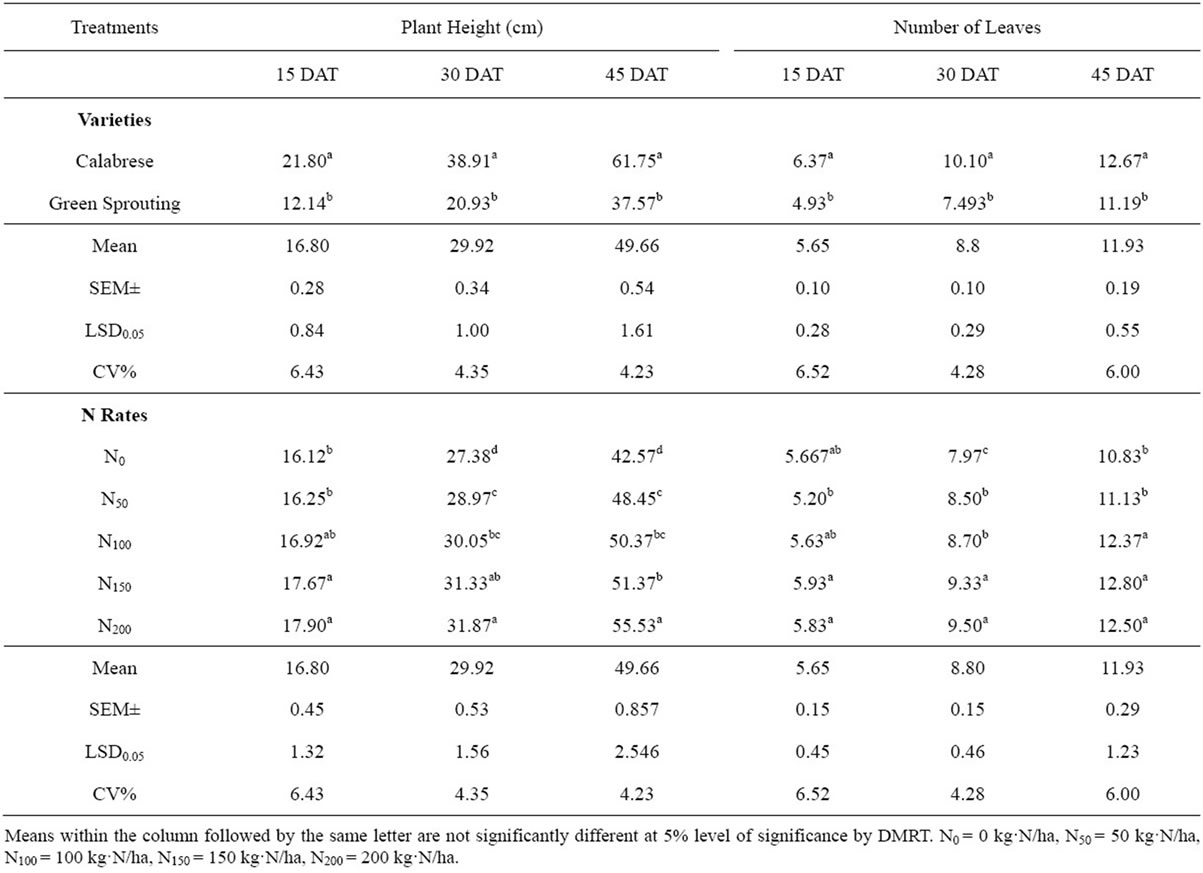
Table 1. Effect of varieties and N rates on plant height and leaf number per plant at different days after transplanting (DAT).
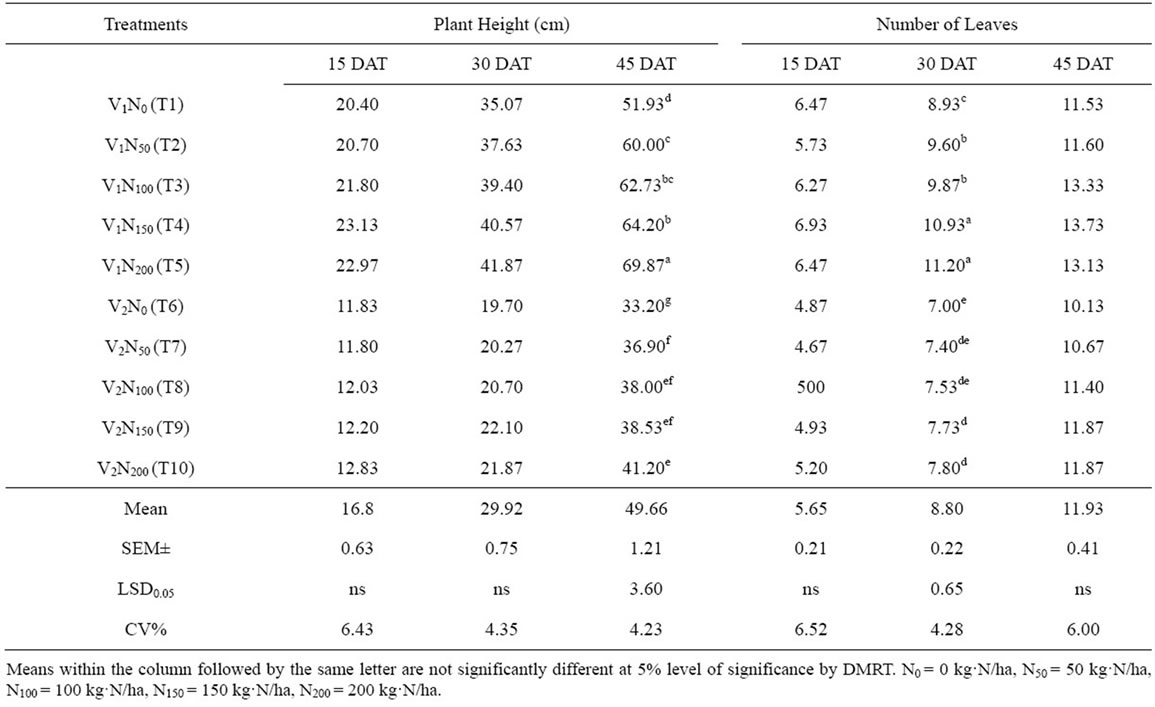
Table 2. Interaction effect of varieties and N rates on plant height and leaf number per plant at different days after transplanting (DAT).
At 45 DAT, the tallest plants were observed in Calabrese at N200 whereas the shortest plants were observed in Green Sprouting at N0.
3.2. Number of Leaves per Plant
Calabrese had significantly higher (P < 0.05) number of leaves than Green Sprouting (Table 1). Similarly, effect of N rate was also significant at all observation dates. Significantly higher numbers of leaves were observed at N150 as compared to N50 and N0 at 15 and 45 DAT. The highest number of leaves was observed at N200 while the lowest number of leaves was obtained at N0 at 30 DAT. Similar positive response of N fertilization in leaf numbers was also observed in other studies [5-7]. Interactive effect of varieties and N rate was non-significant except at 30 DAT (Table 2). Calabrese had the highest number of leaves per plant at N200 while Green Sprouting had the lowest number of leaves per plant at N0 at 30 DAT.
3.3. Days to Heading, and First and Last Harvest
The broccoli varieties differed significantly (P < 0.05) in terms of days to heading, days to first and last harvest (Table 3). Calabrese produced head 26 days earlier and consequently the first and last harvest of the variety was
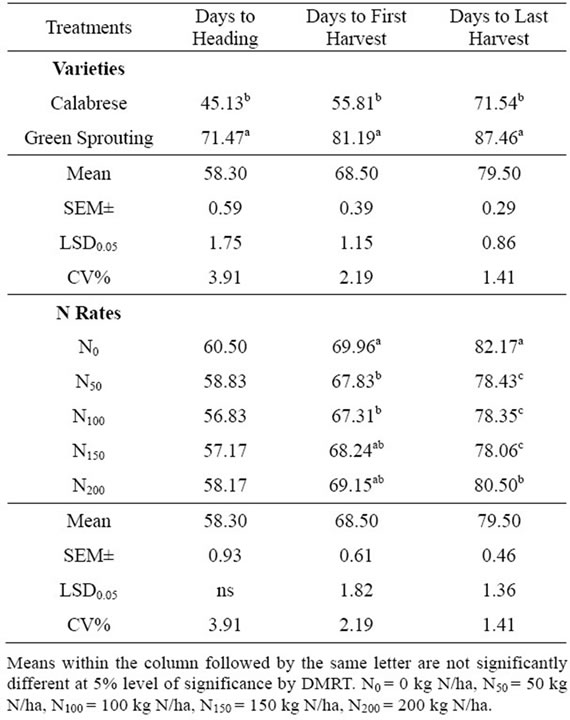
Table 3. Effect of varieties and N rates on days to heading, first harvest and last harvest.
significantly earlier than Green Sprouting. This is important as broccoli produced in early of the growth season can fetch higher price in the market. Effect of N rate on days to heading was non-significant (P > 0.05). However, there effect of N rate was significant (P < 0.05) for the number of days from transplanting to first and last harvest. The broccoli varieties took slightly longer to reach the date of the first and last harvest at N0. In the absence of N application plants had slower rate of growth at N0 whereas N fertilization had stimulated vegetative growth in other treatments. This slower rate of plant growth might be the cause of delayed curd initiation and subsequently more number of days to harvest [8,9]. The interaction effect of varieties and N rate on the days to heading, and the first and the last harvest were non-significant (P > 0.05).
3.4. Length and Diameter of Terminal and Auxiliary curds
Highly significant variation between the varieties in the length and diameter of terminal curd was noticed (Table 4). Calabrese had significantly longer terminal
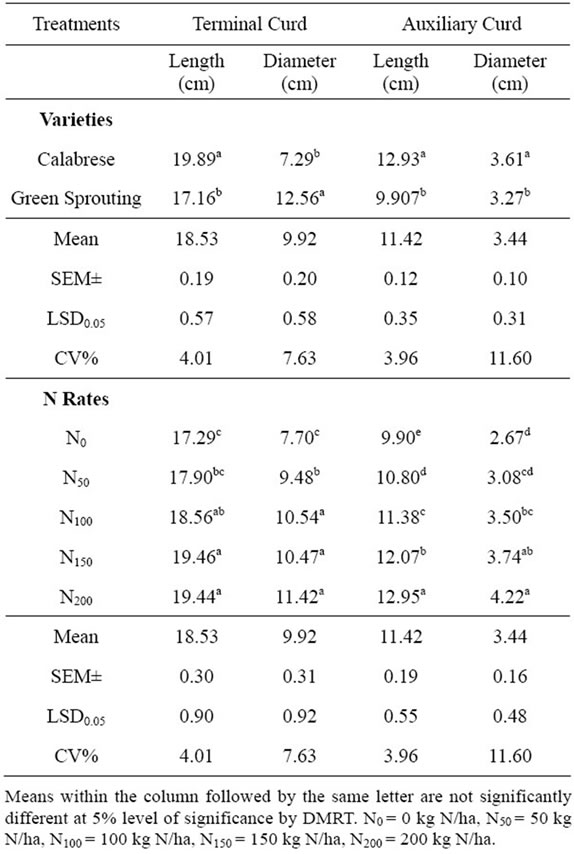
Table 4. Effect of varieties and N rates on length and diameter of terminal and auxiliary curd.
and auxiliary curds. Green Sprouting had wider terminal curds but Calabrese had wider auxiliary curds. Likewise, the effect of N rate on the length and diameter of both terminal and auxiliary curd was observed highly significant. In general, length and diameter of terminal and auxiliary curds increased with increased N rate. Similar response of proportionate increase of length and diameter of head of broccoli with N rate was also observed in other studies [6,10].
Interaction effect of varieties and N rate was non-significant (P > 0.05) for the length of terminal curd and auxiliary curds. The interaction effect was however significant (P < 0.05) for the diameter of terminal curd. The widest curd diameter was in Green Sprouting at N200 while the smallest curd diameter was observed in Calabrese at N0.
3.5. Terminal, Auxiliary and Total Curd Yield
Green Sprouting produced higher terminal cut but auxiliary curd yield was higher in Calabrese (Table 5). Thus, Green Sprouting produced 11% higher (P > 0.05)
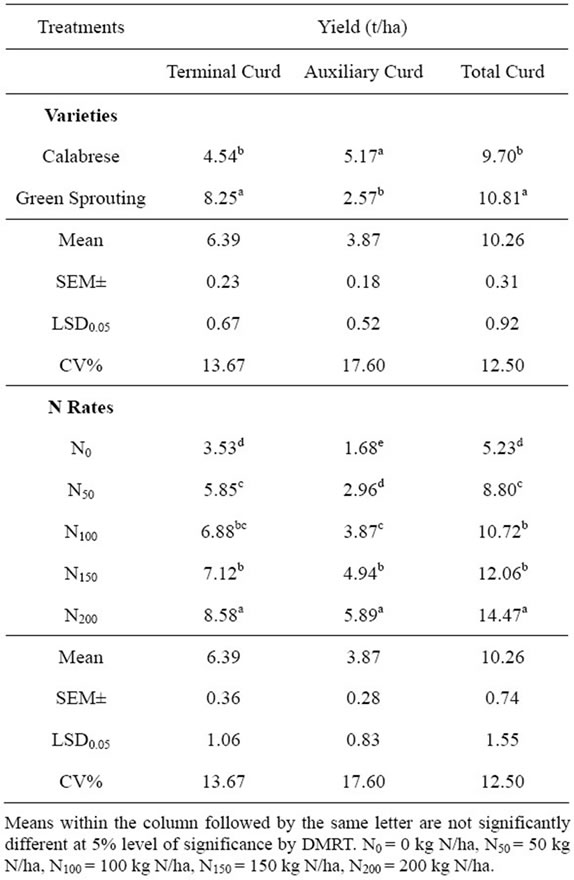
Table 5. Effect of varieties and N rates on yield of terminal, auxiliary and total curd yield of broccoli.
total curd. The effect of N rate on the yield of terminal curd was highly significant. The highest rate of N fertileizer (N200) produced the highest amount of terminal, auxiliary and total curd. The increment in the yield of curd with the increased N rate application may be due to the production of higher amount of photosynthates available for the enlargement of the curds. Increment in the curd yield from increased N rate was also observed in previous studies [6,11-13]. This indicated that optimum level of N could be beyond the rates tested in this study. Interaction of varieties with different N rates on terminal and total curd yield were non-significant. But, it was significant on auxiliary curd yield. Green Sprouting with N0 produced the lowest auxiliary curd yield while Calabrese with N200 produced the highest auxiliary curd.
4. CONCLUSION
The aim of the current study was to optimize nitrogen nutrition of two broccoli cultivars cultivated at western Chitwan, Nepal. Green Sprouting produced 11% higher total curd than Calabrese. Total curd production increased with increased N rate in both cultivars reaching a maximum of 14.47 t ha−1 at N rate of 200 kg ha−1. The results indicated that optimum level of N could be beyond 200 kg ha−1, which needs further experimentation.
5. ACKNOWLEDGEMENTS
This study was financially supported by the Directorate of Research and Publication (DOR) of Institute of Agriculture and Animal Sciences (IAAS), Tribhuvan University, Nepal.
![]()
![]()
REFERENCES
- Ghimire, A.J., Bhattarai, M.R. and Khanal, R. (1993) Effect of removing terminal or auxiliary heads on the yield and quality of seed of broccoli cultivar Green Sprouting. PAC Working Paper, 77, 1-11.
- District Agriculture Development Office (2006) Annual progress report. Government of Nepal, Ministry of Agriculture and Cooperatives, District Agriculture Development Office, Chitwan, 105.
- Gomez, K.A. and Gomez, A.A. (1984) Statistical procedures for agricultural research. 2nd Edition, John Wiley & Sons, New York.
- El-Shikha, D.M., Waller, P., Hunsaker, D., Clarke, T. and Barnes, E. (2007) Ground-based remote sensing for assessing water and nitrogen status of broccoli. Agricultural Water Management, 92, 183-193. doi:10.1016/j.agwat.2007.05.020
- Thakur, O.P., Sharma, P.P. and Singh, K.K. (1991) Effect of nitrogen and phosphorus with and without boron on curd yield and stalk rot incidence in cauliflower. Vegetable Science, 18, 112-121.
- Gomez, R., Khan, M.S. and Islam, M.M. (2000) Effect of irrigation and nitrogen uptake on broccoli in Grey Terrace soil. Bangladesh Journal of Agricultural Research, 25, 423-430.
- Santamaria, P., Elia, A. and Conversa, G. (1994) Growth and yield of broccoli in a vegetable crops sequence. Effects of nitrogen and herbicides. Rivista-di-Agronomia, 28, 135-141.
- Balyan, D.S., Dhankar, B.S., Ruhal, D.S. and Singh, K.P. (1988) Growth and yield of cauliflower cv. Snowball-16 as influenced by nitrogen, phosphorus and zinc. Haryana Journal of Horticultural Science, 17, 247-254.
- Bakker, C.J., Swanton, C.J. and McKeown, A.W. (2009) Broccoli growth in response to increasing rates of preplant nitrogen: II. Dry matter and nitrogen accumulation. Canadian Journal of Plant Sciences, 89, 539-548. doi:10.4141/CJPS08028
- Toivonen, P.M.A., Zebarth, B.J. and Bowen, P.A. (1994) Effect of nitrogen fertilization on head size, vitamin C content and storage life of broccoli (Brassica oleracea var. italica). Canadian Journal of Plant Sciences, 74, 607-610. doi:10.4141/cjps94-109
- Letey, J., Jarell W.M., Valors N. and Beverly R. (1983) Fertilizer application and irrigation management of broccoli production and fertilizer use efficiency. Agronomy Journal, 75, 502-507. doi:10.2134/agronj1983.00021962007500030020x
- Mitra, S.K. (1990) Broccoli. In: Mitra, S.K., Sadhu, M.K. and Boss, T.K., Eds., Nutrition of Vegetable Crops, Naya Prokash, Kolkata, 157-174.
- Vågen, I.M., Aamlid, T.S. and Skjelåg, A.O. (2007) Nitrogen fertilization to broccoli cultivars at different planting times: Yield and nitrogen use. Acta Agriculturae Scandinavica, Section B—Plant Soil Science, 57, 35-44. doi:10.1080/09064710500539224

